The subject of today’s review is a much-talked-about “Cinema 3D” TV from LG Electronics. The LG 47LW550T is an LED-backlit HDTV which features the company’s film-type patterned retarder (FPR) polarized 3D LCD technology that should appeal to viewers who are looking for convenient and shareable access to extra-dimensional content. So without further ado, let’s move on to the review.
<!-- google_ad_client = 'pub-2887677957235196'; google_ad_slot = '4990177225'; google_ad_width = 336; google_ad_height = 280; //-->
Note: The specific model we reviewed was the 47LW550T, which denotes the version equipped with DVB-T2 Freeview HD tuner sold in the United Kingdom. While we did not test the 42-inch LG 42LW550T nor the 55-inch 55LW550T, there shouldn’t be any drastic difference in picture performance bar screen size.
LG is no stranger to crafting beauty with substance, and the 47LW550T certainly fits in this mould. In terms of build quality, the LED LCD TV is well-constructed and rigid thanks to the rear metal enclosure (which also helps to reduce heat build-up).
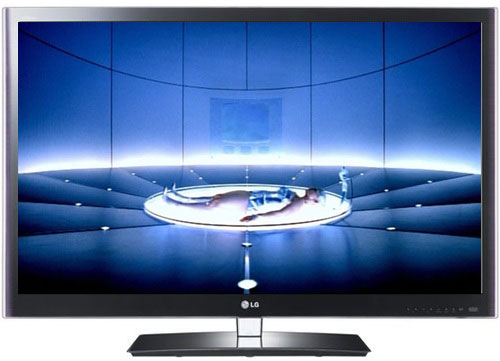
It is worth noting that unpacking and removing the panel proved to be quite difficult (much like the SL9000 I reviewed last year). Due to the thinness of the outer transparent rim, I could not obtain a firm grip without hurting my palm. So it is ideal to have an extra pair of hands as well as two pairs of gloves.
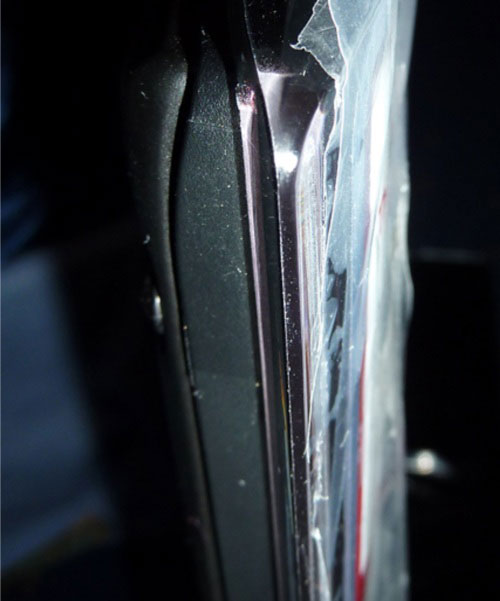
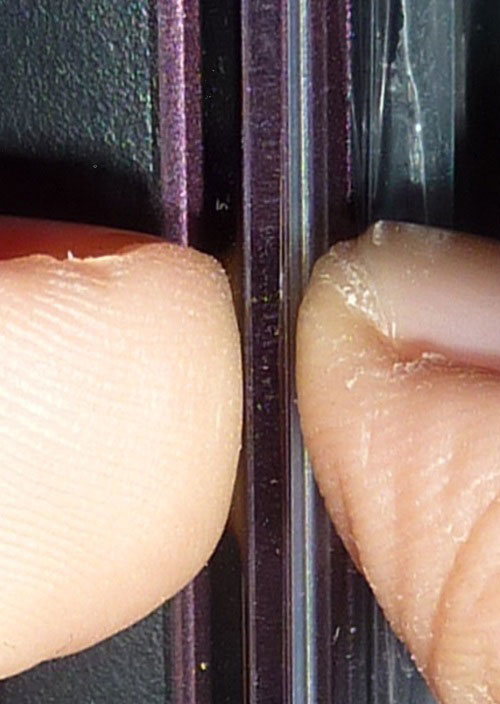
For those who are green-minded, I am sorry to inform that the LG LW550T does not sport a hard power on/off button, therefore during prolonged absence it is best to opt for the wall switch.
The location of the AV ports and the build quality are in keeping with today’s standards, but the power cable is integrated, which could pose a problem for certain users (e.g. those who own UPS).
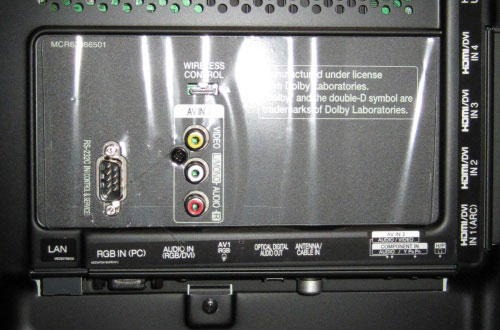
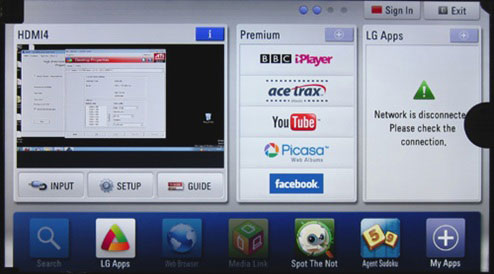 |
| Home menu |
The 47LW550T’s GUI (graphical user interface) is similar to that on last year’s SL9000 with negligible performance improvements, which is a shame since the fluidity of the GUI leaves something to be desired. As an example, navigating from left to right on the SmartTV screen is relatively slow and tedious. The animations also come across as slightly basic and outdated – the Korean TV manufacturer should have optimised the GUI or embedded a GPU (graphics processing unit) to enhance user experience. Thankfully the submenus that house the calibration controls are quite responsive and functional.
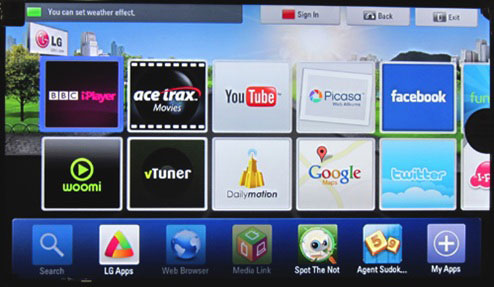 |
| Smart TV menu |
A submenu dubbed “Q.Menu” allows users to configure the picture and sound modes as well as timer and energy saving options. It’s quite useful when switching between ISF 1 and ISF 2.
One of the major selling points of the 47LW550T is the ability to tweak a number of configurations that dictate the overall image quality. Unlike its cross-town rival Samsung, LG still hasn’t released a flat-screen HDTV with full 3D colour management system (CMS), but thankfully the chromaticity on the company’s models is usually very good with minimal delta errors (dEs).
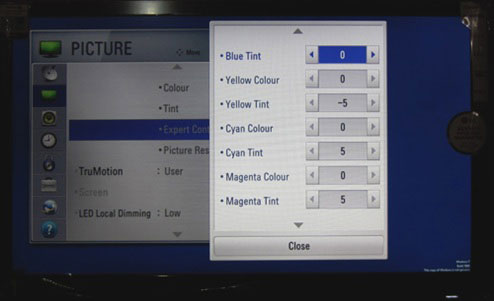 |
| Colour management system (CMS) |
The LG 47LW550T also features independent source customisation, which allows users to finetune and maximise the potential of every video source.
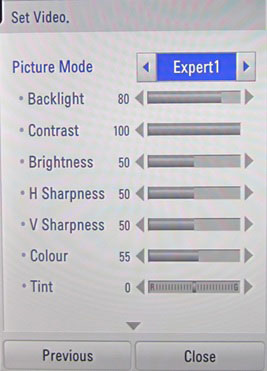 |
| Picture controls |
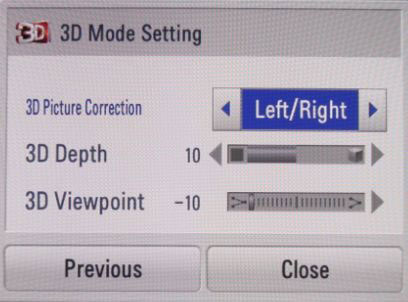 |
| 3D controls |

Complementing the 47LW550T’s lavish looks, the build quality and ergonomics of the infrared remote control is excellent, but the piano finish is prone to the dreaded hairline scratches. Most of the buttons are highly responsive, but the navigation pad is a little stiff, which only adds to the frustration of dealing with slow GUI. The supplied remote features a backlit option, but switch it on only when required as heavy use can lead to rapid depletion of the batteries.

Greyscale and Gamma accuracy are vital for portraying any given image correctly, therefore the display must be calibrated to a set of standards adopted by the broadcast and video industry. In the case of HDTV, the set standard for colour space is Rec. 709 (which is similar to sRGB), and both standards share an identical white point (D65). We chose a gamma value of 2.2.
Greyscale calibration ensures that all greys between black and white are free from colour dominance, which is achieved by assigning the RGB values to 6500K Correlated Colour Temperature (CCT). Regrettably, it is not possible for a consumer-grade display to yield 100% accuracy, so the goal is to maintain errors within acceptable levels (as indicated by Delta E values).
The default ISF mode yielded very good results out of the box. The CCT was very close to a flat 6500k, and colour fidelity was well within tolerance, which means the LG 47LW550T is one of the few true Plug and Play HDTVs on the market.
![Pre-calibration CCT in [ISF] mode](https://www.hdtvtest.co.uk/news/wp-content/uploads/2018/04/hdtv_LG-47LW550T_pre-cct.jpg) |
| Pre-calibration CCT in [ISF] mode with [Colour Temperature] “Warm” |
![RGB Tracking in [ISF] mode](https://www.hdtvtest.co.uk/news/wp-content/uploads/2018/04/hdtv_LG-47LW550T_pre-rgb.jpg) |
| RGB tracking and dEs in [ISF] mode |
For experienced users who wish to improve the picture quality even further, the ISF modes also permit detailed configuration. Oddly, the default contrast is set to 90, which reduces the overall luminance of the LED LCD TV by 20 cd/m2, but on the other hand bumping the contrast to 100 negatively affects the gamma. Since luminance has direct impact on contrast and black level, I decided to sacrifice linear gamma in favour of increased contrast.
![Post-calibration CCT in [ISF] mode](https://www.hdtvtest.co.uk/news/wp-content/uploads/2018/04/hdtv_LG-47LW550T_post-cct.jpg) |
| Post-calibration CCT in [ISF] mode |
![RGB Tracking in [ISF] mode](https://www.hdtvtest.co.uk/news/wp-content/uploads/2018/04/hdtv_LG-47LW550T_post-rgb.jpg) |
| Post-calibration RGB tracking and dEs in [ISF] mode |
![Gamma curve in [ISF] mode after calibration](https://www.hdtvtest.co.uk/news/wp-content/uploads/2018/04/hdtv_LG-47LW550T_post-gamma.jpg) | |
| Gamma curve in [ISF] mode | Corresponding gamma tracking |
![CIE chart in [ISF] mode](https://www.hdtvtest.co.uk/news/wp-content/uploads/2018/04/hdtv_LG-47LW550T_post-cie.jpg) |
| Post-calibration CIE chart with reference to HD Rec.709 |
![Colour luminance levels in [ISF] mode](https://www.hdtvtest.co.uk/news/wp-content/uploads/2018/04/hdtv_LG-47LW550T_post-colour-luminance.png) |
| Colour luminance (coloured bars = targets; grey bars = measured values) |
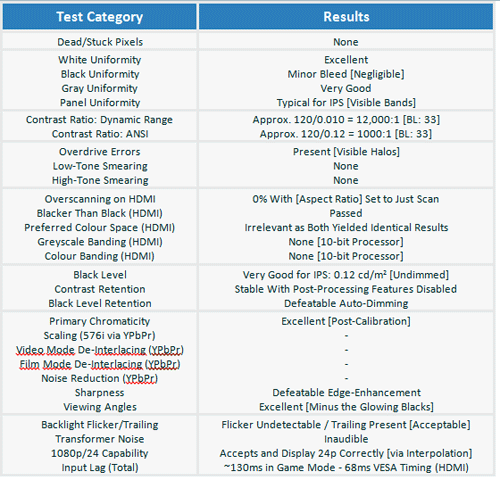
| Default [Normal] mode | 138 watts |
| Calibrated [ISF] mode | 68 watts |
| Standby | <1 watt |
The LG 47LW550T produced excellent overall uniformity, which is quite remarkable for an edge-lit LED-LCD panel. During the pure white test (100IRE), the classic red and green tinting commonly found on LCDs was absent. Backlight bleeding was present, but it was limited to the corners, and the panel uniformity was typical for a consumer-grade display. There were few visible defects and imperfections across the LCD panel. However, such errors are common to most consumer-grade LCDs and are extremely difficult to avoid.
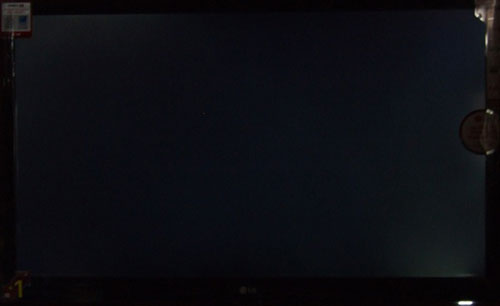 |
| Black uniformity |
Having stated that, screen uniformity has a much greater impact in 3D than in 2D: even faint bands and light smudges can be noticed easily during panning scenes when 3-dimensional depth is thrown in – it’s akin to viewing the world through not-so-clear polymer. Ultimately, this is one area where plasma displays have the upper hand.
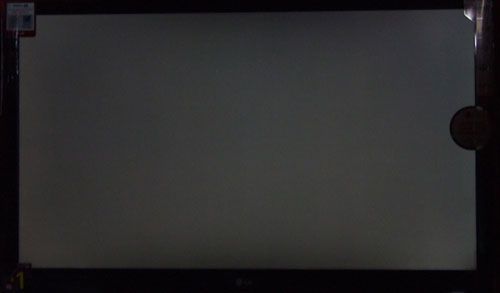 |
| Panel uniformity |
The LG 47LW550T in [ISF Mode] with white level (contrast) set to 100 yielded exceptional dynamic range (aided by auto-dimming) of 12,000:1, and good ANSI (static) value of around 1000:1, which is becoming a norm for S-IPS panels of late. Also, the polarizing filter seems to have little or no negative effect on contrast.
The LG LW550T features side-mounted LED modules, which improves motion clarity but limits the number of separately controllable zones and increases the area covered by each module. Since IPS panels natively have lighter black levels (compared to SPVA counterparts), any variation in average picture level (APL) will be perceptible, and can be aggravating when viewing complex night scenes. As you can see from the following images that highlights the portion covered by each LED module, the haloing effect is quite noticeable.
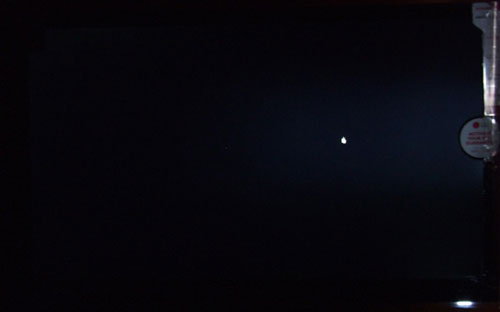
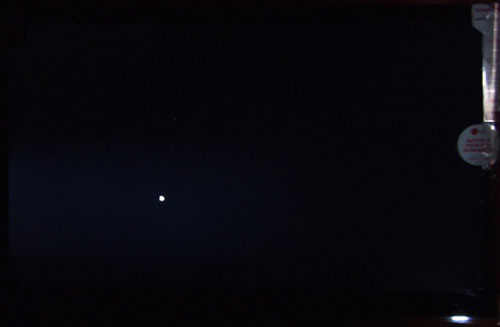
PixPerAn is an excellent tool designed to evaluate motion artefacts, and it immediately highlighted the usual overdrive errors that are still common to IPS LCD panels. Thankfully the over-shoot errors didn’t translate into serious artefacts.
| Pixel structure of AS-IPS LCD panel |
As stated above, the LG 47LW550T features side-mounted LED modules, which means that each LED module can be synced to the LCD screen to create an effective backlight scanning system. You may be aware that traditional backlight scanning has caused more problem than it solved mainly because the backlight wasn’t in sync with the LCD panel, and the pixel response time exceeded the hold time (resulting in lower image contrast/ ghost images). I am happy to report that LG’s implementation is a successful one, as I failed to spot any obvious artefact (minus a few ghost images). However, backlight scanning alone cannot improve motion resolution to a sufficient degree, so a form of FRC (Frame Rate Converter) is needed – in this case a cost-effective real-time MCFI (Motion Compensated Frame Interpolation).
LG’s implementation of MCFI over the years has not really been up to par: year after year, we failed to notice any major improvements. The low-to-high motion conversion in particular was plagued with inconsistent motion and blocky (pixelated) artefacts that occurred during complex scenes. This year, the Korean TV maker has finally seen sense and completely overhauled its MCFI system thus drastically improving the image quality. In fact, it is safe to say the company’s MCFI algorithm now belongs in the top five (if not the top three). During high-motion tests, the motion remained smooth and clean with no visible artefacts. Converting low-motion to high-motion (which some refer to as movie to soap) also yielded superb results. The onboard MCFI was able to process complex scenes without any artefacts, and correctly avoided processing extremely complex scenes. Overall, an excellent balance was struck, and even though most people do not prefer the soap look (or even slightly softened motion), it does in fact make a world of difference in 3D. And the LW550T does offer the option to configure the level of processing, so the user can enjoy smoother motion without destroying the film look.
Overscanning: The aspect ratio can be configured by pressing [Q.Menu] button on the remote, and the HDTV supports 1:1 pixel mapping in 2D but not in 3D due to the passive system.
Blacker-than-Black (HDMI): The LG 47LW550T accepts both 0-255 and 16-235 formats over HDMI (RGB).
Viewing Angle: The 47LW550T is fitted with LG’s latest AS-IPS LCD panel, which is known for its excellent viewing angles minus the glowing blacks when viewed off angle (which remained valid during the gamma and colour shift tests). In order to completely eliminate the glowing black problem, a True-White Polarizer is required, but due to its substantial cost, it is limited to ultra-high-end monitors.
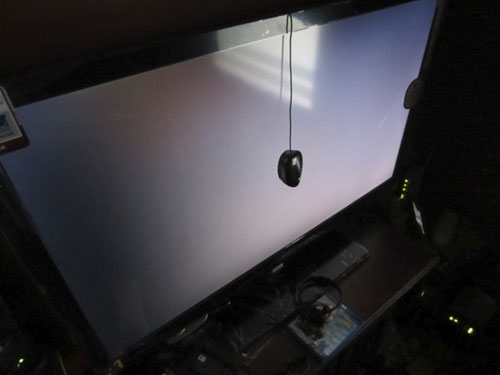
Unlike 2D, tri-dimensional viewing presents additional problems especially on passive 3D systems based on interlaced format. Due to the inter-horizontal structure of the polarized film, vertical viewing angle is significantly limited while horizontal viewing angle remains unaffected. So if the centre of the 3DTV is 85cm from the floor, anyone standing will having difficulty experiencing optimal 3D effects even from 2.4 meters away.
Sharpness: The 47LW550T features independent Horizontal and Vertical sharpness, which can be configured to enhance certain content such as standard definition or poorly mastered DVD, or disabled entirely to obtain hands-off mode without any edge enhancement.
To evaluate the image quality rendered by the LG LW550T, a small number of carefully chosen images were used to detect visible artefacts/errors. The first image of Aeon was used to detect errors in skin tone, luminance and depth, whereas the Acela Express picture was used to detect greyscale and gamma errors in addition to black crush.
Note: The tests were conducted under [ISF 1].

The 47LW550T yielded excellent results out of the box with Image Mode set to ISF. The complex shades of warm colours that envelop Charlize Theron’s face, neck and chest were clearly visible. A sense of depth was also present. Minor tweaking yielded slightly better results but most users should be very happy with the default ISF settings… just make sure [Contrast] is set to 100.

As expected, the greyscale performance of the LG 47LW550T was excellent. There was no evidence of any serious black crush nor any form of gamma error.
High-definition material were beautifully rendered on the LG 47LW550T as expected, thanks to the new and improved 10-bit processor. I failed to spot any form of error that would normally destroy or severely impact the image quality, which remained clean and faithful to the source (I used a mixture of test patterns and show reels designed to highlight flaws). Colour shift and colour luminance were also stable and well within tolerance, which means the image quality on screen was very close to the original source. Owing to the wide viewing angle of IPS LCD panel, the picture appeared very natural and realistic (even when viewing dark contents). There was no hint of translucent blacks that is common to VA panels with their excessive gamma shifts. Speaking of blacks, the LW550T did a good job of retaining acceptable levels of shadow detail (with auto-dimming off). Enabling auto-dimming caused more artefacts than it solved due to the limited number of zones and the high native black level of IPS panel. Personally I do not wish to state that the 47LW550T has poor blacks primarily due to the IPS panel, which has only broken the 1000:1 ANSI barrier last year. So it is not the case of whether LG could have improved the black level, but rather a limitation of the IPS Mode. Truth be told, IPS is far superior to VA in every regard except the black, which is only a problem when viewing in a environment with no/ minimal ambient light.
In terms of visible artefacts, there was virtually none (except a few light panel banding) thanks to the excellent 10-bit processor onboard. LG Electronics has certainly got the video processing right.
On a negative note, the 47LW550T lacks true 24p support (even pulldown). The LED TV accepted 1080p24 video, but the signal was converted via uneven pulldown unless MCFI is engaged. Setting both [De-Judder] and [Anti-Blur] to 0 on the LW550T resulted in even motion devoid of the soap opera look, but ultimately the image was processed. When I tried a complex test pattern, interpolation artefacts became quite clear. Thankfully such artefacts were nowhere to be seen when I viewed test samples designed to emulate real-world consumer content.
Since formally adopting Passive 3D as its primary format, LG has been on a tireless crusade to get the format accepted by consumers. Unfortunately, the Passive System developed by the company does not deliver the highest resolution, because the user is only exposed to 540p per eye, which may result in visible scanlines. From the recommended viewing distance of 2.4 meters, I was able to detect the drop in resolution as well as the scanlines. When watching motion video, the lower resolution wasn’t too obvious, but the scanlines were and I found them to be rather unpleasant (especially when there’s a scene with depth involved). In a sense, it can be classified as an undesirable artefact. However, crosstalk was negligible and flicker was nowhere to be seen, therefore the on-screen image was much easier on the eye. If LG can reduce the gap between the lines and double the vertical resolution (or split each pixel in half), then it would have no problem beating the competing format.
 |
| 1080p vs 540p with visible scanlines |
As for colour and greyscale, the Korean television manufacturer has taken the time to configure the ISF option for extra-dimensional viewing, and the end result is very impressive. The default ISF settings yielded fairly clean greyscale and realistic colours, which I’m sure most will find appealing.
LG’s implementation of 2D-to-3D conversion isn’t the most advanced, since it splits individual frames into three sections to calculate depth, which may lead to warping and distortion (as illustrated below). However, it is quite effective in creating 3D depth, and is ideal for showing off home movies and 2D contents to friends and families.
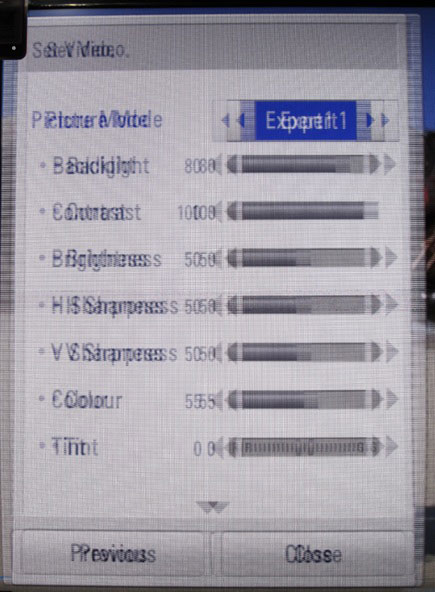
To be fair, LG isn’t really charging a premium for the 3D capabilities on the 47LW550T: one could argue that 3D is actually included free of charge with the HDTV, perhaps as a stop-gap solution for consumers to enjoy 3DTV without depleting their savings. That said, at this time of writing an active-shutter system is required to experience 3D Blu-Ray in all its full HD 3D glory.
Gaming on the LG 47LW550T is next to impossible due the extremely high input lag. I’ve never seen a flat-screen TV with 130ms input lag under Game Mode. I was able to reduce the lag to around 60ms by sending VESA timings, but only the Microsoft Xbox 360 and the PC are capable of sending VESA timings via HDMI/DVI. In spite of this, 60ms is too high even for casual games as it adds to the total lag (which includes controller lag, game lag, processing lag, frame lag etc.).
As with all slim LED-LCD displays, the audio quality is acceptable for soaps and news but probably inadequate for movies and music, so it is advisable to spend some money on a pair of active speakers or a home cinema system.
LG managed to produce a 3D TV that is both effective and practical for the majority of consumers. Even though the 47LW550T cannot resolve 1080 vertical lines in 3D mode, it is quite capable of delivering compelling 3D experience without a premium price tag. Unfortunately due to the high input lag, we had to qualify our recommendation. If the Korean TV manufacturer can release a patch to improve the lag, then we will be happy to recommend the LW550T without any reservation.

<!-- google_ad_client = 'pub-2887677957235196'; google_ad_slot = '0693194791'; google_ad_width = 336; google_ad_height = 280; //-->